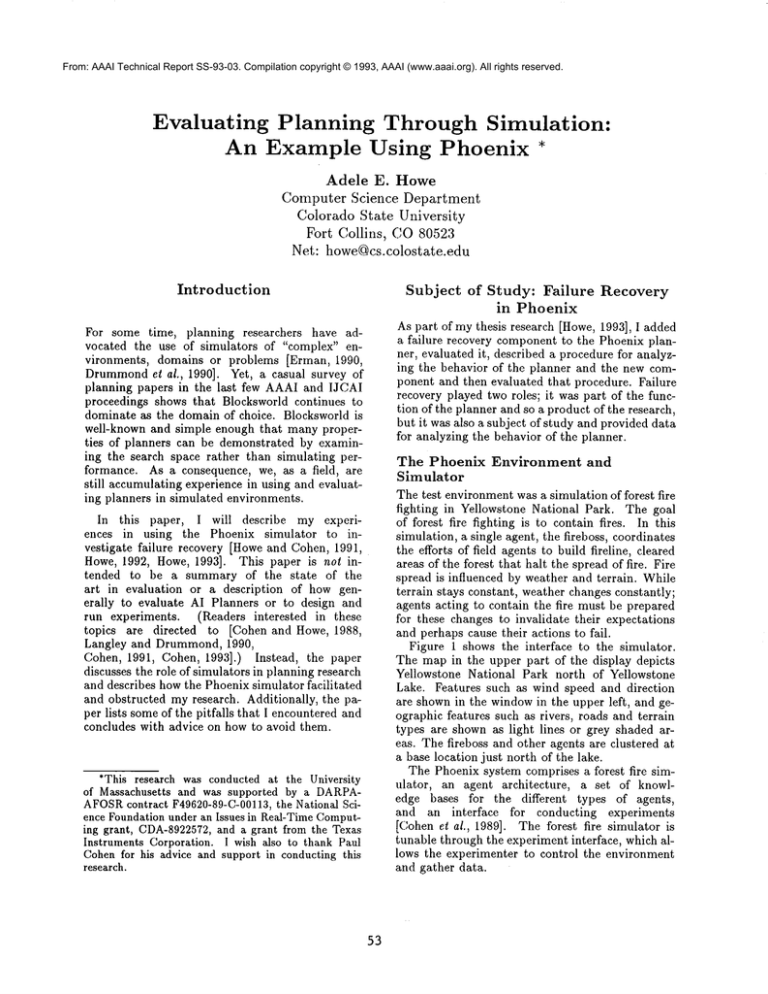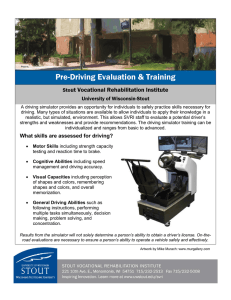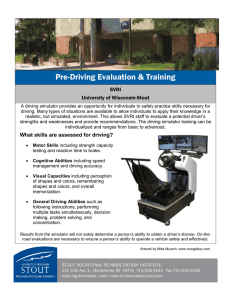
From: AAAI Technical Report SS-93-03. Compilation copyright © 1993, AAAI (www.aaai.org). All rights reserved.
Evaluating Planning Through Simulation:
An Example Using Phoenix *
Adele E. Howe
Computer Science Department
Colorado State University
Fort Collins, CO80523
Net: howe@cs.colostate.edu
Introduction
For some time, planning researchers
have advocated the use of simulators of "complex" environments, domains or problems [Erman, 1990,
Drummondet al., 1990]. Yet, a casual survey of
planning papers in the last few AAAIand IJCAI
proceedings shows that Blocksworld continues to
dominate as the domain of choice. Blocksworld is
well-known and simple enough that many properties of planners can be demonstrated by examining the search space rather than simulating performance. As a consequence, we, as a field, are
still accumulating experience in using and evaluating planners in simulated environments.
In this paper, I will describe my experiences in using the Phoenix simulator to investigate failure recovery [Howeand Cohen, 1991,
Howe, 1992, Howe, 1993]. This paper is not intended to be a summary of the state of the
art in evaluation or a description of how generally to evaluate AI Planners or to design and
run experiments. (Readers interested
in these
topics are directed to [Cohen and Howe, 1988,
Langley and Drummond, 1990,
Cohen, 1991, Cohen, 1993].) Instead, the paper
discusses the role of simulators in planning research
and describes how the Phoenix simulator facilitated
and obstructed my research. Additionally, the paper lists someof the pitfalls that I encountered and
concludes with advice on how to avoid them.
*This research was conducted at the University
of Massachusetts and was supported by a DARPAAFOSR
contract F49620-89-C-00113,the National Science Foundation under an Issues in Real-TimeComputing grant, CDA-8922572,and a grant from the Texas
Instruments Corporation. I wish also to thank Paul
Cohenfor his advice and support in conducting this
research.
Subject of Study: Failure Recovery
in Phoenix
As part of mythesis research [Howe,1993], I added
a failure recovery component to the Phoenix planner, evaluated it, described a procedure for analyzing the behavior of the planner and the new component and then evaluated that procedure. Failure
recovery played two roles; it was part of the function of the planner and so a product of the research,
but it was also a subject of study and provided data
for analyzing the behavior of the planner.
The Phoenix
Environment
and
Simulator
The test environment was a simulation of forest fire
fighting in Yellowstone National Park. The goal
of forest fire fighting is to contain fires. In this
simulation, a single agent, the fireboss, coordinates
the efforts of field agents to build fireline, cleared
areas of the forest that halt the spread of fire. Fire
spread is influenced by weather and terrain. While
terrain stays constant, weather changes constantly;
agents acting to contain the fire must be prepared
for these changes to invalidate their expectations
and perhaps cause their actions to fail.
Figure 1 shows the interface to the simulator.
The map in the upper part of the display depicts
Yellowstone National Park north of Yellowstone
Lake. Features such as wind speed and direction
are shown in the windowin the upper left, and geographic features such as rivers, roads and terrain
types are shown as light lines or grey shaded areas. The fireboss and other agents are clustered at
a base location just north of the lake.
The Phoenix system comprises a forest fire simulator, an agent architecture,
a set of knowledge bases for the different
types of agents,
and an interface
for conducting experiments
[C’ohen et al., 1989]. The forest fire simulator is
tunable through the experiment interface, which allows the experimenter to control the environment
and gather data.
+
+
-F
l:’:’:l:’:’:
+
1F
1F
16:89 fireboss-1:Monitoringtl-plan-envlfirelproJectlon-3.2
lfi/1
Figure 1: Viewfrom Phoenix simulator of bulldozers fighting a fire.
The experimenter can control two aspects of the
environment: the initial state and the way the
environment changes over time. Initial state includes the numberof agents of different types, what
they know and how they are initially situated in
the world. Environmental change is controlled by
scripts, which describe the type, amount, time and
frequency of changes to the environment. Any environment parameter can be changed with scripts;
typically, the scripts change dynamicfeatures such
as wind speed, wind direction, humidity, temperature, moisture content of parts of the park (e.g.,
as in when it rains), and the location and incidence of fire. Scripts can also specify the collection of time-stamped data at intervals over an experimental trial. Alternatively, the experiment can
collect data on the environment and the agents, accessing any process information available, in retrospect, about the execution. For the agents, this
includes their long-term memories about what they
’thought’, how they acted, and how they perceived
the environment.
Failure
Analysis
Recovery
and Failure
Recovery
Plan failures are common
in some environments. In
fact, both execution time and planning time fail-
ures are commonfor agents in Phoenix. For my research, I combined two approaches to limiting the
frequency and impact of failures: automated failure
recovery and debugging failures. Automated failure recovery both repaired failures and expedited
debugging the Phoenix planner using a procedure
called Failure Recovery Analysis (or FRA).
The automated failure recovery component applies general methods to recover from failures detected by the Phoenix planner. The design of the
failure recovery component was based on an expected cost model of failure recovery. The model
served as the basis of three experiments in which
I tested the assumptions of the model, compared
two strategies for selecting recovery methods (one
of which was derived from the model), and evaluated the performance of the system after adding
two new recovery methods.
Failure recovery analysis is a procedure for analyzing execution traces of failure recovery to discover how the planner’s actions might be causing
failures. The procedure involves statistically
analyzing execution traces for dependencies between
actions and failures, mapping those dependencies
to plan structures, and explaining how the structures might produce the observed dependencies. I
evaluated the procedure by applying it to explain
Complexity
Simple Closed
World
/ Simulated Complex
]
Controlled RealJ
I,
control to the experimenter. In each experiment, I
tested hypotheses about the performance of failure
recovery under varying conditions; the experiment
interface allowed me to specify which aspects of the
experiment should be changed and which should remain the same.
UncontrolledReal
Environment
Figure 2: Spectrum of Complexity of Domains for
Planning
some results of the experiments in which I evaluated automated failure recovery and by analyzing
the Phoenix data for FRA’ssensitivity to noise and
size of the execution traces.
Role
of the
Simulator
Although Blocksworld is the most commonplanning domain, planners have been constructed for
many different
domains from simple and easily described to complicated and hard to understand fully. Figure 2 positions the different domains on a spectrum. Blocksworld is the best
known example of a constrained closed world domain. At the other end of the spectrum are
uncontrolled, "real" environments that either involve the normal complexity of everyday human
life or are particularly challenging even for humans; the JPL Planetary Rover [Miller et al., 1982]
and the Transportation Planning Problem for USTRANSCOM
[Day, 1992] exemplify such domains.
Between the almost trivial
and almost impossible lies both simulated complex environments and
controlled real environments. Examples of simulated complex environments include Phoenix and
Tileworld [Pollack and Ringuette, 1990]; an example of a constrained real environment is an underwater remotely-piloted robot in a test tank
[Bonasso, 1991].
The Phoenix simulator was integral to my research on failure recovery. First, the simulator provided a platform in which to test the feasibility of
the design for failure recovery. I designed a failure
recovery component and modeled it; the simulator
helped demonstrate the utility of the failure recovery design and was used to test the assumptions
of the model. Second, the simulator allowed the
collection of data from 30,000 simulated hours of
fire fighting (without burning a single tree). The
failure recovery research involved manypilot studies and four experiments, which together required
three weeks of execution time on a TI Explorer.
Without the simulator, I could not have run enough
trials to test statistical significance and wouldnever
have noticed long-term trends in the data, trends
that motivated the design of Failure Recovery Analysis. Third, the experiment interface expedited
testing hypotheses because it grants considerable
55
Advantages
of Using a Simulator
The obvious advantage of a simulator is that the
experimenter is in control. One can define the conditions that should hold in the environment to test
one’s hypothesis or evaluate the performance of a
system. Additionally, instrumentation is easily obtained by adding hooks to the planner or simulator.
Embedding the planner in a simulated environment with an experiment interface supports "soup
to nuts" inquiry. Manystages of experimentation
can be automated, from running trials and collecting data to partially interpreting the results. With
the facilities in the simulator, I wrote code to run
multiple trials of the experiment, gather data, process the data and perform basic statistical analyses
on it.
Another advantage of simulation is that it expedites comparing the behavior of the system over
time and across environment conditions. I was able
to gather execution data on the long term effects of
planning actions and to search for commonbehaviors in differing conditions of the environment.
Simulators are portable domains. We can copy
software from one system to another and expect
that it will perform roughly the same. Simulators
offer us the chance to replicate and compareresults
on shared metrics.
The possibilities for replication and the ability
to define whatever metrics we want mean that it
should be possible to generalize results beyond a
single simulator. Whenwe can look inside the environment to see what it is doing, we should also be
able to disregard superficial differences, such as between forest fire fighting and oil spill containment,
and recognize the commonalities in approach.
Disadvantages
of Using a Simulator
Although my research could not have progressed
without a simulator, using Phoenix did have its
downside. One major problem with complex simulation is that so mucheffort can be expended acquiring domain-specific knowledgethat any results
obtained from the planner may be specific to the
domain. In other words, it can become difficult
to attribute credit for the system’s performance:
was the algorithm responsible or was the knowledge
base? I found that my approach to failure recovery worked for Phoenix, but at present, I can only
argue, based on the requirements of the approach
and similarities in the characteristics of the environments, that it will work in other environments.
The most often cited problem with simulators is
that they are not the real world, but are only approximations of it. In particular, simulators tend
to avoid dealing with the realities of noisy sensors
and faulty effectors [Gini, 1988]. Additionally, they
do not capture richness of sensation or true parallelism and so can mislead us about what will work
in "real" environments.
Simulators depend on their hardware and software platforms. The major problem with this dependence is that it can be difficult to predict the
effects of changes in hardware or software. I determined early in mypilot studies that I needed to
run the experiments on machines with exactly same
configuration (hardware, operating system and application software) because the same experiments
took longer to run and the results did not look comparable on other "similar" machines.
Simulators may give a false feeling of control.
The effect of the platform is one factor that may
cause hidden differences. Other factors that I had
difficulty controlling were: system stability, programmingerrors that led to collecting different data
than I had intended, and updates to the software.
Whenexperimenting with a new system, one should
expect a lot of bugs and system crashes to occur;
in fact, with Phoenix, we sometimes spent days
fixing the system after installing modifications to
make Phoenix stable enough to run hours of experiments without crashing. Also, instrumentation
is not immune to programming bugs. The hardest aspect to control was the installation of new
software: patches and updates to the platform and
to the simulator. Myexperiments were run over
a period of several months; in that time, I could
not prevent programmers from fixing bugs and support people from installing updates. In at least one
case, I know that an update introduced a bug in
the planner. The bug produced data that was dramatically different from a previous experiment and
made comparing results from the two experiments
a questionable activity. As it happened, that experience had the positive effect that I realized I could
detect bugs in the program by simply looking at the
data I had collected, but I paid for the serendipity
by a loss in generality of other results.
the pitfalls of experimentation with a complex simulator.
First, pilot studies are essential! Bugs need to
be worked out of both the planner and the experimentitself. Typically, the simulator will create situations that the programmers never thought to or
did not have the time to test. The experiment may
sound good on paper, but may not be adequately
controlled. I ran three pilot studies to test the simulated conditions of myexperiment and still had to
run the first experiment twice because of corrupted
data.
Second, the planner and the simulator should be
isolated from modifications. Unless you can be certain that no one can change the system (planner
and simulator) during the experiment, the results
from one controlled experiment may not actually
be the same as those in the "same" experiment run
later.
Third, dependent and independent variables
should be selected carefully and understood thoroughly. Because of a difference in the representation of different actions, I implementedthe instrumentation for one dependent variable with a test
for the type of action. I thought the difference was
largely syntactic, but in fact, analyzing the data
showed that the value of the dependent variable depended, oddly enough, on another dependent variable and did not measure what I had intended it to
measure.
Fourth, experiments based on concrete hypotheses are mucheasier to understand and critique than
exploratory experiments. Exploratory experiments
are important for helping narrow the hypotheses,
but the results should be viewed as preliminary.
Simulators have been invaluable in identifying
canonical problems and in making ideas concrete.
However,their flexibility and ease of use can lead us
astray. In particular, we need to learn howto factor
in the contribution of knowledgeto the performance
of systems, howto formulate and test hypotheses in
simulated environments and how to generalize our
results beyond a single planner in a single simulator.
References
Exploiting
the Advantages
Avoiding the Pitfalls
While
Simulators provide a remarkable flexibility and degree of control for evaluating planners. The problem is that it is so easy to dash off experimentsthat
the results can be uninterpretable. As in any experimental activity, one needs to have clearly stated
hypotheses and needs to ensure that the experiment
is indeed testing those hypotheses under adequately
controlled conditions. Based on myexperiences, I
offer the following suggestions for avoiding someof
56
Bonasso, R. Peter 1991. Underwaterexperiments using a reactive system for autonomousvehicles. In Proceedingso] the Ninth NationalCon/erenceon Artificial
Intelligence, Anaheim,CA. AmericanAssociation for
Artificial Intelligence. 794-800.
Cohen, Paul R. and Howe, Adele E. 1988. Howevaluation guides AI research. AI Magazine9(4):35-43.
Cohen, Paul R.; Greenberg, Michael; Hart, David M.;
and Howe,Adele E. 1989. Trial by fire: Understanding
the design requirementsfor agents in complexenvironments. AI Magazine10(3).
Cohen, Paul R. 1991. A survey of the eight national
conference on artificial intelligence: Pulling together
or pulling apart? AI Magazine 12(1):16-41.
Cohen, Paul R. 1993. Empirical Methods in Artificial
Intelligence. In Preparation.
Day, David S. 1992. Acquiring search heuristics automatically for constraint-based planning and scheduling. In Hendler, J., editor 1992, Artificial Intelligence
Planning Systems: Proceedings of the First International Conference (AIPS92), San Mateo, CA. Morgan
Kauflnann Publishers, Inc. 45-51.
Drummond,Mark E.; Kaelbling, Leslie P.; and Rosenschein, Stanley J. 1990. Collected notes from the
benchmarks and metrics workshop. Artificial Intelligence Branch FIA-91-06, NASAAmes Research Center.
Erman, Lee D. 1990. Intelligent
real-time problem
solving (IRTPS): Workshop report. Technical Report
TTR-ISE-90-101, Cimflex Teknowledge Corp.
Gini, Maria 1988. Automatic error detection and recovery. Computer Science Dept. 88-48, University of
Minnesota, Minneapolis, MN.
Howe, Adele E. and Cohen, Paul R. 1991. Failure
recovery: A model and experiments. In Proceedings
of the Ninth National Conference on Artificial Intelligence, Anaheim, CA. 801-808.
Howe, Adele E. 1992. Analyzing failure recovery to
improve planner design. In Proceedings of the Tenth
National Conference on Artificial Intelligence. 387393.
Howe, Adele E. 1993. Accepting the Inevitable: The
Role of Failure Recovery in the Design of Planners.
Ph.D. Dissertation, University of Massachusetts, Department of Computer Science, Amherst, MA.
Langley, Pat and Drummond, Mark 1990. Toward an
experimental science of planning. In Sycara, Katia P.,
editor 1990, Proceedings of the Workshop on Innovative Approaches to Planning, Scheduling and Control.
Morgan Kaufmann Publishers, Inc. 109-114.
Miller, David P.; Desai, Rajiv S.; Gat, Erann; Ivlev,
Robert; and Loch, John 1982. Reactive navigation
through rough terrain: Experimental results. In Proceedings of the Tenth National Conference on Artificial
Intelligence, San Jose, CA. 823-828.
Pollack, Martha E. and Ringuette, Marc 1990. Introducing the Tileworld: Experimentally evaluating
agent architectures.
In Proceedings of the Eight National Conference on Artificial Intelligence, Boston,
MA. 183-189.
57



